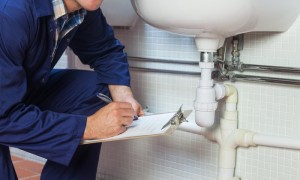In the 1920’s, lead was commonly found in many plumbing systems. In fact, the word “plumbing” is derived from the Latin word “plumbum,” which means lead and was used for a long time because of its ability to resist pinhole leaks while being pliable enough to form into shapes to deliver water. When in use as a component of a waste system, it is not an immediate health threat, but as a component of potable water pipes it can be a definite health-hazard which is why homes built after 1986 incorporate lead-free products.
Plumbing systems have common components, but they are not uniform. In addition to fixtures, these components include gas pipes, water pipes, pressure regulators, pressure relief valves, shut-off valves, drain and vent pipes, and water-heating devices, some of which we do not test if they are not in daily use. The best and most dependable water pipes are copper, because they are not subject to the build-up of minerals that bond within galvanized pipes, and gradually restrict their inner diameter and reduce water volume. Water softeners can remove most of these minerals, but not once they are bonded within the pipes, for which there would be no remedy other than a re-pipe.
The water pressure within pipes is commonly confused with water volume, but whereas high water volume is good – high water pressure is not. In fact, whenever the street pressure exceeds eighty pounds per square inch a regulator is recommended, which typically comes factory preset between forty-five and sixty-five pounds per square inch. However, regardless of the pressure, leaks will occur in any system, and particularly in one with older galvanized pipes, or one in which the regulator fails and high pressure begins to stress the washers and diaphragms within the various components.
Waste and drainpipes pipes are equally varied, and range from modern ABS ones [acrylonitrile butadiene styrene] to older ones made of cast-iron, galvanized steel, clay, and even a cardboard-like material that is coated with tar. The condition of these pipes is usually directly related to their age. Older ones are subject to damage through decay and root movement, whereas the more modern ABS ones are virtually impervious to damage, although some rare batches have been alleged to be defective. However, inasmuch as significant portions of drainpipes are concealed, we can only infer their condition by observing the draw at drains. Nonetheless, blockages will occur in the life of any system, but blockages in drainpipes, and particularly in main drainpipes, can be expensive to repair, and for this reason we recommend having them video-scanned. This could also confirm that the house is connected to the public sewer system, which is important because all private systems must be evaluated by specialists.
We inspect many homes and businesses in Osceola County and we tend to see the same type issues in many of our home inspections.The most common plumbing defects include old and incompatible piping materials and faulty fixtures or waste lines. These may require simple repairs, such as replacing a fixture, or more expensive measures, such as replacing the plumbing system itself.
Buy Your Side Home Inspection provides you with an objective visual examination of the physical structure and systems of your home, from the roof to the foundation. Call us today. 407.780.0911.


Follow Us!